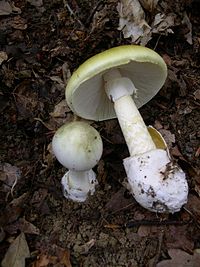
Photo from wikipedia
Objective To describe and analyze the clinical characteristics and outcome of amatoxin poisoning cases. Methods We performed a retrospective cohort study of amatoxin poisoning cases from Ramathibodi Poison Center Toxic… Click to show full abstract
Objective To describe and analyze the clinical characteristics and outcome of amatoxin poisoning cases. Methods We performed a retrospective cohort study of amatoxin poisoning cases from Ramathibodi Poison Center Toxic Exposure Surveillance System, from May 2013 to August 2015. Results There were 30 consultations with a total of 55 poisoning cases. Most cases were male and from the north-east region. Hepatitis, acute kidney injury, jaundice, and coagulopathy accounted for 74%, 46.3%, 44.7%, and 52.8% of the cases, respectively. Almost all of the patients were admitted to the hospital, and the median duration of hospital stay was found to be 4 days. Mortality rate was found to be 27.3%. Most patients (73%) received the treatment including multiple-dose activated charcoal (67.5%), intravenous N-acetylcysteine (87.5%), and benzylpenicillin (45%). In 60% of the cases, the treatment was initiated within 24 h after eating mushrooms. Exchange transfusion and liver transplantation were performed in one severe case. However, this patient died eventually. Because intravenous silybinin is not available in Thailand during the study period, 8 patients received oral silymarin instead. All 8 patients had hepatitis and were treated with high dosage of oral silymarin (5 patients with 4.48 g/day, 2 patients with 1.68 g/day, and 1 patient with 1.4 g/day) for a couple of days. One of these patients died as she received treatment very late; she was treated with silymarin at 1.68 g/day dosage. Thus, the fatality in oral silymarin treatment group was 12.5%. We performed the analysis between the dead and survival groups. We found that in hepatitis, initial and maximum serum aspartate transaminase, initial and maximum serum alanine transaminase, and acute kidney injury were significantly different between the two groups. Conclusion Amanita mushroom poisoning caused high fatalities. Serum transaminase and creatinine were the factors associated with death. Treatment with oral high dose silymarin should be investigated further as one of the principal therapies in amatoxin poisoning.
Journal Title: International Journal of General Medicine
Year Published: 2017
Link to full text (if available)
Share on Social Media: Sign Up to like & get
recommendations!